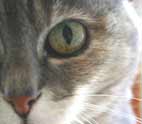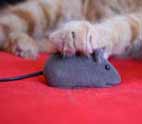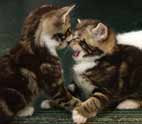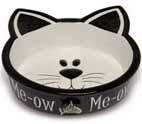Use Cat Toys
When Playing For A Happy Cat
So you've given your pet some cat toys but they remain unused in the corner of the room.
This is a common experience for a lot of cat owners and one that isn't considered a great problem in the great scheme of things. But it may mean that your cat is bored, un-stimulated or even depressed. -
The importance of play to our cats is something that most humans don't realise and it can play an important role to their physical and emotional health. A natural and very strong cat instinct is to hunt and playtime can be the closest thing a cat gets to actually being able to carrying out this natural behavior.
But to hunt, a cat needs to be fast, confident and agile and without play they can quickly become lazy, shy, fearful, overweight and generally a very miserable cat. So interactive play between you and your cat using various toys is an important part of your relationship with your pet.
It will also help to build a stronger bond between you both as your cat will associate you with fun and excitement and actively seek out your companionship.
The Main Benefits Of Cat Play
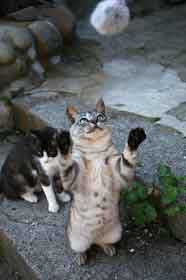
How Often Should I Play With My Cat?
A cat is a very intelligent and active creature when out in the wild and to keep our domesticated cats happy and healthy you should ideally play with your cat at least twice a day:
In the morning before you leave for work - This will leave your kitty felling relaxed and confident while you are away. It will also have used up energy which may other wise be used to scratch up your furniture by a frustrated cat.
Evening playtime - ideally soon after you return from work as your cat may have slept for most of the day and now be full of energy again. If you have a very alert cat at nighttime that wants to keep you awake by meowing and running around, it may also be advisable to have a play session half an hour before you go to bed, to use up this energy.
Each play session need only last for about 10 to 15 minutes and will largely be dictated by your cat as to how long they want to play for. Some cats will quite happily play for this length of time whilst others will be satisfied after only 5 minutes.
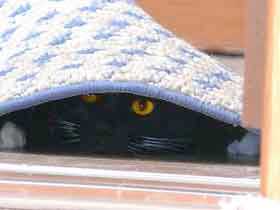
How To Play With Your Cat
This may sound like a funny question, surely you just throw a ball and watch them go chase it. Well yes sometimes this will work, but look at it from your cats point of view, it can get pretty monotonous after awhile and as most cat toys are fairly inanimate items, it doesn't really get their hunting instincts stimulated.
Not all cats like the same sorts of cat toys. For instance some cats may prefer to hunt for things on the ground like mice, whist others prefer to hunt for flying things like birds. Knowing what stimulates your cat best will help you to play with your cat more effectively and provide your cat with the most fun and stimulus.
A Ground hunter - If your cat prefers to hunt things on the ground, you will need to provide cat toys that look like mice or are small furry items that make a crinkle sound. Make the playtime as exciting and as realistic as possible by moving the cat toys in such a way so that they mimic the movements and actions of a mouse. You can also:
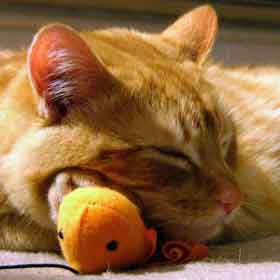
- Provide plenty of hiding places for your cat to pounce from by placing some open paper bags around the floor for your cat to hide in.
- Vary the movements of the cat toys by making them scuttle across the floor by dragging them on a piece of string
- Make some of the movements fast, others slow
- Hide the cat toys behind and under things
- Let him catch the toy sometimes, this will boost his confidence.
A Sky hunter - these cats prefer to climb up onto things to try and catch their prey. So the toys that are best for these cats are feathery colourful cat toys on string, which you can tantalizing dangle in front of the cat in the air.
- Again vary the actions of the toy by sometimes making it land on something and then fly away.
- Make some of the movements fast others slow, even still.
When the game is over, make sure that the cat toys you use to play with your cat are put away and only leave a few cat balls out for him to play with on his own. This will stop him becoming bored with the same old toys all the time. Also remember to buy new cat toys from time to time, again this will stimulate interest and prevent toys from becoming boring and tattered.
Using Treats
The use of treats during playtime should only be used when trying to get an unresponsive cat used to playing with you. Some cats who may be low in self-confidence or who are fearful may find the initial use of cat toys and play sessions over whelming and may try to hide. The use of treats to entice them out and to gain their interest may help initially, but should not be continually used.
The use of treats should really be confined in rewarding good behaviour and to help behaviour modification, such as when trying to get new pets accepted by an existing pet. The over use of treats can also be harmful to a cats health as over time they can be responsible for an increase in weight or a nutritional imbalance.


